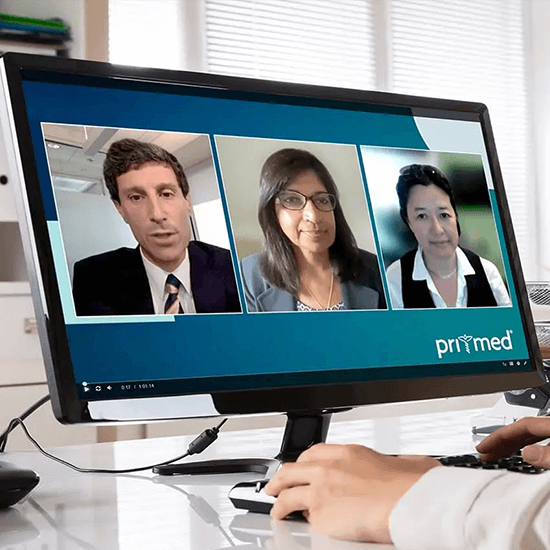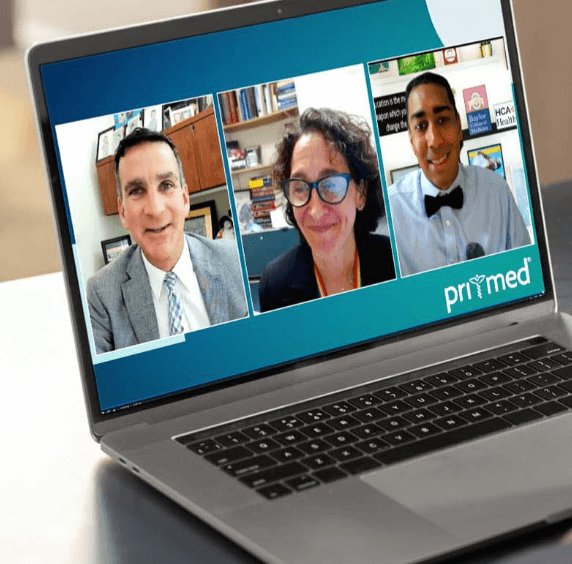Free CME
16 - 30 of 76 results
-
FREE
ScientiaCME Tackling a sore subject: best practices in the identification and management of psoriatic arthritis (PsA)
- Cost: Free
- Credit hours: 1
- Format: On-Demand Online
- Material last updated: 06/22/2024
- Expiration of CME credit: 06/22/2026
-
FREE
Free Physician Assistant Courses from Pri-Med® – Designed for Primary Care Clinicians
Pri-Med offers a diverse library of physician assistant CME/CE, providing clinically focused education for every stage of your career. Whether you’re a newly practicing physician assistant transitioning from the classroom to the exam room or an experienced clinician, you’ll find the resources you need to grow professionally.
See full details chevron_right- Cost: Free
- Credit hours: .25 - 1.25
- CME credits awarded by: Pri-Med Institute
- Format: On-Demand Online
-
FREE
Free Pharmacology Courses from Pri-Med® – Designed for Primary Care Clinicians
Understanding pharmacologic management of disease is a crucial aspect of providing high-quality medical care. Our courses offer practical guidance on pharmacologic management of disease processes to avoid potentially negative interactions between substances. Choose from a variety of free pharmacology CME/CE courses to improve care for your patients. Earn credits at no cost today.
See full details chevron_right- Cost: Free
- Credit hours: .25 - 4
- CME credits awarded by: Pri-Med Institute
- Format: On-Demand Online
-
FREE
ScientiaCME On the road to eliminating pneumococcal diseases: a focus on vaccination practice in adults
Streptococcus (S.) pneumoniae is a common bacterium and one of the leading causes of community-acquired pneumonia (CAP), causing 27% of cases worldwide and 15% of U.S. cases – an important figure because CAP is a major cause of morbidity and mortality. Not only is acute respiratory illness one of the top ten causes of death in the U.S., but it is associated with a 17% all-cause mortality rate 30 days after presentation and a 38% rate after one year. For those admitted to the ICU – accounting for nearly a quarter of those hospitalized with CAP the corresponding morality rates are 27% and 47%, respectively.
See full details chevron_right- Cost: Free
- Credit hours: 1
- Format: On-Demand Online
- Material last updated: 09/05/2024
- Expiration of CME credit: 09/05/2026
-
FREE
Nurse Practitioner CME/CE Courses from Pri-Med® – Designed for Primary Care Clinicians
Explore Pri-Med’s comprehensive library of nurse practitioner CME/CE courses, designed to support clinicians at every stage of their career. Whether you’re a new nurse practitioner transitioning from training to practice or an experienced clinician seeking to deepen your expertise, Pri-Med offers a diverse range of clinically focused courses tailored to your needs. Enhance patient care and earn CME/CE credits with engaging, high-quality education—start today.
See full details chevron_right- Cost: Free
- Credit hours: Varies
- Format: Online Video, Online Audio, Online Article
-
FREE
ScientiaCME Initial- and later-line treatment considerations in advanced renal cell carcinoma (RCC)
- Cost: Free
- Credit hours: 1
- Format: On-Demand Online
- Material last updated: 05/21/2024
- Expiration of CME credit: 05/21/2025
-
FREE
ScientiaCME Taking the next step in the management of relapsed or refractory follicular lymphoma
- Cost: Free
- Credit hours: 1
- Format: On-Demand Online
- Material last updated: 06/28/2024
- Expiration of CME credit: 06/28/2025
-
FREE
ScientiaCME Straightening out our approach to the management of cervical dystonia: optimizing treatment strategies
Activity Description / Statement of Need:
In this online, self-learning activity:
Cervical dystonia is the most common focal dystonia, characterized by involuntary muscular contractions resulting in abnormal head, neck, and shoulder movements in addition to posture that can cause tremor and pain. Early-onset dystonia can begin in infancy, childhood, or adolescence, and it generally progresses from focal to generalized. Adult-onset dystonia usually affects the upper part of the body; the origin of the dystonia determines the risk of spread. Cervical dystonia may appear as torticollis, laterocollis, anterocollis, or retrocollis. It may be distinguished from nondystonic hand tremor and essential tremor by the absence of limb tremor and the manner of neck movement. However, it is more difficult to distinguish from pseudodystonias, resulting in misdiagnosis and inappropriate treatment.
Target Audience:
The following HCPs: medical neurologists; physician assistants, nurse practitioners, and pharmacists who practice in neurology; and other clinicians who commonly encounter patients with cervical dystonia.
See full details chevron_right- Cost: Free
- Credit hours: 1.25
- CME credits awarded by: ScientiaCME
- Format: On-Demand Online
- Material last updated: May 19, 2023
- Expiration of CME credit: May 19, 2025
-
FREE
ScientiaCME Aiming for the mark: achieving target pressures in open-angle glaucoma (POAG)
- Cost: Free
- Credit hours: 1
- Material last updated: 08/17/2024
- Expiration of CME credit: 08/17/2026
-
FREE
ScientiaCME Organizing our thoughts around unmet needs novel approaches to the management of schizophrenia
- Cost: Free
- Credit hours: 1
- Format: On-Demand Online
- Material last updated: 05/05/2024
- Expiration of CME credit: 05/05/2026
-
FREE
ScientiaCME Pancreatic Cancer: Updates from the 2024 American Society of Clinical Oncology (ASCO) Annual Meeting
Over 64,000 people develop and close 50,000 die each year of pancreatic cancer, and by 2030, pancreatic cancer is expected to surpass colorectal and breast cancer to become the second-leading cause of cancer death. Over 90% of whom have pancreatic ductal adenocarcinoma (PDAC), and while the 5-year survival rate for patients diagnosed with localized disease is over 44%, patients with locally advanced (LAPC) or metastatic disease have a median overall survival of 12 to 14 months. Symptoms associated with pancreatic cancer are not usually evident in the early stages of the disease and may be intermittent and nonspecific, and more than half of patients have advanced disease by the time they are diagnosed.
See full details chevron_right- Cost: Free
- Credit hours: .75
- Format: On-Demand Online
- Material last updated: 09/21/2024
- Expiration of CME credit: 09/21/2025
-
FREE
ScientiaCME Cholangiopathy management updates with an eye on the horizon: focus on primary biliary and primary sclerosing cholangitis
- Cost: Free
- Credit hours: 1
- Format: On-Demand Online
- Material last updated: 07/19/2024
- Expiration of CME credit: 07/19/2026
-
FREE
ScientiaCME Neuropsychiatry – Psychiatry
Target Audience: Psychiatrists
See full details chevron_right- Cost: Free
- Credit hours: 2
- CME credits awarded by: ScientiaCME
- Format: On-Demand Online
- Expiration of CME credit: Two years after release
-
FREE
ScientiaCME Contemporary approaches and emerging therapies for the management of respiratory syncytial virus in infants and young high-risk children
Activity Description / Statement of Need:
In this online, self-learning activity:Respiratory syncytial virus (RSV) is a highly contagious pathogen belonging to the Pneumoviridae family that circulates seasonally with other respiratory viruses. The majority of the population is exposed to RSV, but children under the age of two years and older adults are at the greatest risk of significant morbidity and mortality. RSV infections are responsible for approximately 60-80% of pediatric bronchiolitis and 40% of pediatric pneumonia cases and are a major cause of global hospitalization and mortality. Almost 70% of children are exposed to RSV during their first year of life, and 90% are exposed within their first two years, resulting in an estimated 427,000 emergency department visits and 1.6 million pediatrician visits annually.
Target Audience:
See full details chevron_right
HCPs including: Obstetricians, pediatricians, and family medicine physicians; physician assistants, nurse practitioners, pharmacists specializing in pediatrics; and any other HCPs involved or interested in the management of RSV in infants and high-risk children.- Cost: Free
- Credit hours: 1
- CME credits awarded by: ScientiaCME
- Format: On-Demand Online
- Material last updated: October 15, 2023
- Expiration of CME credit: October 15, 2025
-
FREE
ScientiaCME Advanced systemic mastocytosis: from recognition to treatment
Activity Description / Statement of Need:
In this online, self-learning activity:Systemic mastocytosis (SM) is a heterogeneous group of disorders caused by proliferation of abnormal clonal mastocytes, which accumulate in the skin and/or other organ systems. Mastocytosis, including SM, was reclassified as a distinct disease subtype in 2016, when the World Health Organization (WHO) removed mastocytosis from the myeloproliferative neoplasm (MPN) group. The WHO defines 5 SM subtypes, ranging from indolent SM, which is associated with mild symptoms and near-normal life expectancy, to mast cell leukemia, which is an aggressive hematologic malignancy associated with median survival of less than 1 year.
Target Audience:
See full details chevron_right
HCPs including: hematology/oncology specialists, allergists, and clinical immunologists, dermatologists; physician assistants, nurse practitioners, and pharmacists who practice in those areas of specialty; and any other healthcare professionals with an interest in or who may clinically encounter patients with systemic mastocytosis.- Cost: Free
- Credit hours: 1
- CME credits awarded by: ScientiaCME
- Format: On-Demand Online
- Material last updated: September 28, 2023
- Expiration of CME credit: September 28, 2025






